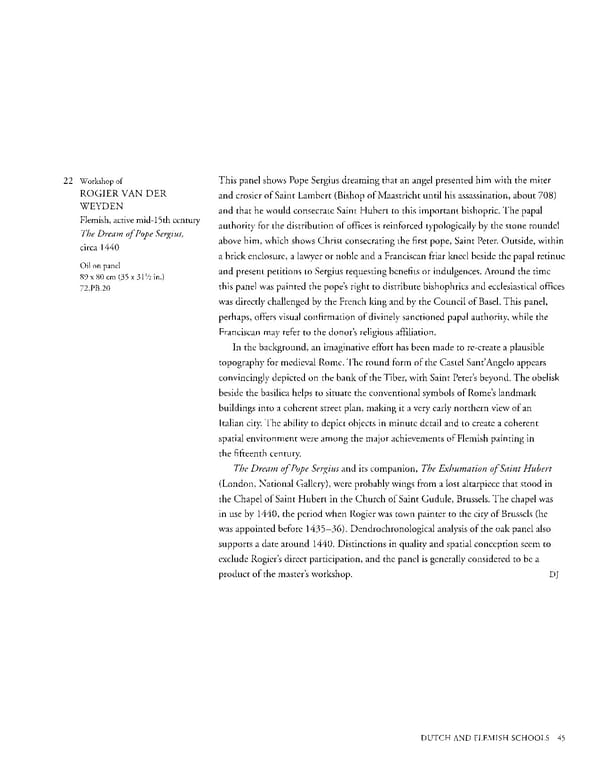22 Workshop of This panel shows Pope Sergius dreaming that an angel presented him with the miter ROGIER VAN DER and crosier of Saint Lambert (Bishop of Maastricht until his assassination, about 708) WEYDEN and that he would consecrate Saint Hubert to this important bishopric. The papal Flemish, active mid15th cenrury authority for the distribution of offices is reinforced typologically by the stone roundel The Dream of Pope Sergius, above him, which shows Christ consecrating the first pope, Saint Peter. Outside, within circa 1440 a brick enclosure, a lawyer or noble and a Franciscan friar kneel beside the papal retinue Oil on panel and present petitions to Sergius requesting benefits or indulgences. Around the time 89 x 80 cm (35 x 31 ½ in.) 72.PB.20 this panel was painted the pope's right to distribute bishophrics and ecclesiastical offices was directly challenged by the French king and by the Council of Basel. This panel, perhaps, offers visual confirmation of divinely sanctioned papal authority, while the Franciscan may refer to the donor's religious affiliation. In the background, an imaginative effort has been made to recreate a plausible topography for medieval Rome. The round form of the Castel Sant'Angelo appears convincingly depicted on the bank of the Tiber, with Saint Peter's beyond. The obelisk beside the basilica helps to situate the conventional symbols of Rome's landmark buildings into a coherent street plan, making it a very early northern view of an Italian city. The ability to depict objects in minute detail and to create a coherent spatial environment were among the major achievements of Flemish painting in the fifteenth century. The Dream of Pope Sergius and its companion, The Exhumation of Saint Hubert (London, National Gallery), were probably wings from a lost altarpiece that stood in the Chapel of Saint Hubert in the Church of Saint Gudule, Brussels. The chapel was in use by 1440, the period when Rogier was town painter to the city of Brussels (he was appointed before 1435—36). Dendrochronological analysis of the oak panel also supports a date around 1440. Distinctions in quality and spatial conception seem to exclude Rogier's direct participation, and the panel is generally considered to be a product of the master's workshop. DJ DUTCH AND FLEMISH SCHOOLS 45
 Masterpieces of the Getty Museum: Paintings Page 45 Page 47
Masterpieces of the Getty Museum: Paintings Page 45 Page 47